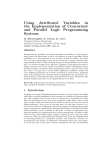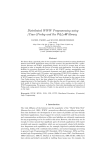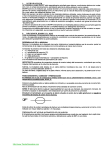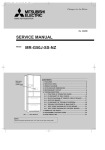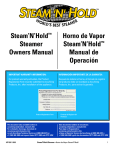Download On The Uses of Attributed Variables in Parallel and Conciirrent
Transcript
On The Uses of Attributed Variables
in Parallel and Conciirrent Logic Programming Systems*
(Extended Abstract)
M. Hermenegildo
D. Cabeza
M. Carro
{herme,dcaheza,mcarro}
@dia.ñ. upm.es
Facultad de Informática
Universidad Politécnica de Madrid (UPM)
28660-Boadilla del Monte, Madrid - SPAIN
A b s t r a c t : Incorporating the possibility of attaching attributes to variables in a logic programming
system has been shown to allow the addition of general constraint solving capabilities to it. This
approach is very attractive in t h a t by adding a few primitives any logic programming system can
be turned into a generic constraint logic programming system in which constraint solving can be user
defined, and at source level - an extreme example of the "glass box" approach. In this paper we propose
a different and novel use for the concept of attributed variables: developing a generic parallel/concurrent
(constraint) logic programming system, using the same "glass box" flavor. We argüe t h a t a system which
implements attributed variables and a few additional primitives can be easily customized at source level
to implement many of the languages and execution models of parallelism and concurrency currently
proposed, in both shared memory and distributed systems. We illustrate this through examples.
K e y w o r d s : Logic Programming, Attributed Variables, Generic Implementations, Parallelism, Concurrency.
1
Introduction
A number of concepts and implementation techniques
have been recently introduced which allow extending
unification in logic languages in a flexible and useraccessible way. One example is t h a t of
meta-structures,
introduced by Neumerkel [19], which allow the specification by the user of how unification should behave
when certain types of terms, called meta-structures and
marked as such by the user, are accessed during unification.
More or less at the same time, the d a t a type attributed variable was introduced by Hoitouze [14] with
the purpose of implementing memory management optimizations such as early reset and variable shunting. Although the behavior of attributed variables during unification was not specified in this work, a number of applications were proposed including the implementation of
delayed computations, reversible modification of terms,
and variable typing. Earlier, Carlsson [2] used a d a t a
type called suspensión, which was incorporated into SICStus Prolog for the implementation of coroutining facilities. "Attributed variables" and "suspensión variables"
are essentially the same objects. Hoitouze's contribution was to put some emphasis on the d a t a type as such
and on memory management. He also used attributed
variables as a low level primitive for the implementation
of mechanisms t h a t necessitated the specification of the
behavior of the d a t a type during unification.
potential for achieving both genericity and reasonable
speed is illustrated by the relatively good performance
exhibited by the Eclipse system [7], which has been used
in many practical applications.
Inspired by the previously discussed use of attributed
variables we propose a different and novel use for such
variables in a completely different context: developing
generic parallel/concurrent (constraint) logic programming systems, using the same "glass box" flavor. Our
A refined versión of the concept of meta-structures proposal shares with those previously discussed the oband attributed variables was used in [12, 13] for the spec- jective of providing a generic system. But our interest foification and implementation of a variety of instances of cuses on implementing concurrent and parallel languages
the general C L P scheme [15]. Implementations of clp(R) and execution models. Attributed variables have already
(i.e. constraint solving over the "reals") and clp(Q) (i.e. been used to implement the coroutining (delay) facilities
constraint solving over the rationals) on top of SlCStus- present in many Prolog systems - often what is actuProlog [3] using the concept of attributed variables have ally being done is in fact restoring such capabilities after
been presented by the same authors and illustrate the having "cannibalized" the delay mechanism support for
power of the approach. By enhancing the SlCStus- implementing the attributed variables. However, we arProlog system with attribute variables they essentially güe t h a t a system which implements both support for
provide a generic system which is basically a SlCStus- attributed variables and a few additional primitives reProlog "clone" but where the unification mechanism has lated to concurrency and parallelism can do much more
been changed in such a way t h a t the user may introduce t h a n simply restoring the delay mechanism. In fact, it is
interpreted terms and specify their unification through our thesis t h a t using the primitives mentioned above it is
possible to easily implement many of the languages and
Prolog predicates.
execution models of parallelism and concurrency curThis approach is very attractive in t h a t it shows t h a t
rently proposed. We illustrate this through examples
by adding a few primitives any logic programming sysand we discuss how quite complex concurrent languages
tem can be turned into a generic constraint logic proand parallel execution models can be implemented usgramming system in which constraint solving can be
ing only such primitives. Furthermore, we argüe t h a t
user defined, at the source level - an extreme example of
t h a t this can be done in a seamless and user-transparent
the "glass box" approach. Another system which impleway in both shared memory and distributed systems.
ments constraint solving using similar techniques is the
Thus, one additional advantage of our technique is t h a t
Eclipse system developed at E C R C [7].
it relates and reunites the two main approaches curWhile this approach in principie has drawbacks from
rently used in concurrent logic programming, and which
the performance point of view (our measurements show are seen traditionally as unrelated: "shared variable"
t h a t the performance obtained can be up to an order systems, in which communication among parallel tasks
of magnitude slower t h a n a specialized implementation is done through variables, and "distributed" or "blackof a constraint logic programming language such as e.g. board" systems in which communication is done through
CLP(3¿)[16], CHIP [18], ProloglII [6], BNRProlog [20], explicit built-ins which access shared channels or global
etc.) the convenience and generality of the approach d a t a áreas.
can make it very worthwhile in many cases. FurtherWe have implemented our technique by adding supmore, the speed can be easily increased in interesting
cases (such as perhaps those of the domains supported port for attribute variables and the concurrency primiby the concrete systems mentioned before) by writing tives (most of these primitives were already in the systhe unification handlers in a lower-level language. 1 The tem) to &-Prolog, a system which efficiently supports
1
I n fact, the speed differential between the attribute variable
/ meta-term approach (with the constraint solving algorithms implemented in Prolog) and the native implementations seems to
pretty much correspond to the differential between "C" and Prolog, the languages in which the constraint solving algorithms are
implemented respectively.
and-parallelism on both shared memory and distributed
architectures [11, 9]. It should be noted t h a t the use t h a t
we propose of attributed variables in the implementation
of concurrency and parallelism does not in any way prevent their simultaneous use also for other purposes, such
as the original one of constraint solving.
The rest of the paper proceeds as follows: Section
2 provides a minimal introduction to attribute variables
and the related primitives. Section 3 then describes the
minimal concurrent / parallel language t h a t we assume.
Sections 4 and 5 provide two concrete examples of the
application of attributed variables proposed. In Section
4 we sketch an implementation of the DDAS scheme for
parallel execution of Prolog, while in Section 5 we present
a way of implementing concurrent logic programming
languages in a distributed environment. Finally, in Section 6 we discuss other uses ofthe technique and propose
lines of future research.
Space limitations forcé the presentation to cover only
some basic cases and give incomplete implementations.
For more details the reader is referred to [10]. Our objective is simply to point out and substantiate to some
extent the great potential t h a t in our view the concept of
attributed variables has in the implementation of generic
parallel, concurrent, and distributed logic programming
systems.
2
Attributed Variables and Related Primitives
We provide a brief introduction to attributed variables.
We follow mainly Holzbaur's description of their implementation in the SICStus Prolog clone.
2.1
General Concepts
Attributed variables are variables with an associated "attribute." Attributes are terms which are attached to
variables, and which are accessed in a special way during unification and also through special built-in predicates. As far as the rest of a given Prolog implementation
is concerned, attributed variables behave like variables.
The indexing mechanism treats variables and attributed
variables in the same way. Also, built-in predicates observe attributed variables as if they were ordinary variables. Special treatment for attributed variables does
apply in the following situations:
• Notably, during unification. When an attributed
variable is to be unified with another attributed
variable or some other non-variable term, userdefined predicates specify how this unification has
to be performed.
• When printed via ' p r i n t / 1 ' , a user-supplied predicate gets a chance to print the attributed variable
in some customized fashion.
2.2
Manipulation
ables
of A t t r i b u t e d
Vari-
The following is a list of typical predicates which provide for the introduction, detection, and manipulation
of attributed variables:
• g e t ^ a t t r i b u t e ( X , C ) If X is an attributed variable, unify the corresponding attribute with C,
otherwise fail.
• a t t a c h ^ a t t r i b u t e ( X , C ) Turn the free variable X
into an attributed variable with attribute C. C
must not be a variable. (Attaching an attribute
to variable generally changes the identity of the
variable.)
• d e t a c h ^ a t t r i b u t e ( X ) Remove the attribute from
an attributed variable, turning it into a free variable. (Detaching the attribute from a variable generally changes the identity of the variable.)
• u p d a t e ^ a t t r i b u t e ( X , C ) Change the attribute of
the attributed variable X to C. Acts as as an attach, followed by a detach, but might be more
(memory) efficient.
Note t h a t all operations on attributed variables behave correctly (i.e. they are undone) upon backtracking.
2.3
Unification in t h e Presence of Att r i b u t e d Variables
Attributed variables are dealt with specially during unification. Essentially, the different possible cases are handled as follows:
• A unification between an unbound variable and an
attributed variable binds the unbound variable to
the attributed variable.
• When an attributed variable is about to be bound
during unification to a non-variable term or another attributed variable, the attributed variable
and the valué it should be bound to are recorded
internally.
• If there is more t h a n one binding event for attributed variables between two inference steps, a
list of attributed variable-value pairs is collected
internally.
• At the next inference step, the pending attributed
variable-value pairs are supplied to user-defined
handlers which are Prolog predicates.
The handlers for the unification of attributed variables mentioned above are provided by the user by means
of the following predicates:
• v e r i f y ^ a t t r i b u t e ( C , T ) This user-defined predicate is invoked when an attributed variable with
an attribute which unifies with C is about to be
unified with the non-variable term T.
• c o m b i n e ^ a t t r i b u t e s ( C l ,C2) This user-defined
predicate is invoked when two attributed variables
with attributes C1,C2 are about to be unified.
Note t h a t the two predicates are not called with the
attributed variables involved, but with the corresponding attributes instead. The is done for reasons of simplicity and efficiency (e.g. indexing). Note t h a t if access
to the actual attributed variable is needed the variable
itself can be included in the attribute.
2.4
Other Related Primitives
In general, a number of other primitives are often provided which allow pretty printing and dumping of the
results in a user understandable format.
2.5
A t t r i b u t e d Variables And Coroutining — an Example
The following example, due to [12] serves both to ¿Ilústrate the use of the primitives introduced in the previous
section and also to recover the functionality of f r e e z e
since attribute variables are, as mentioned in the introduction, most easily implemented in practice by "cannibalizing" an existing implementation of f r e e z e :
f r e e z e ( X, Goal) : a t t a c h _ a t t r i b u t e ( V, f r o z e n ( V , G o a l ) ) ,
X = V.
verify_attribute( frozen(Var,Goal), Valué) :detach_attribute( Var),
Var = Valué,
call(Goal).
combine_attributes( frozen(Vl,G1), frozen(V2,G2))
detach_attribute( VI),
detach_attribute( V2),
VI = V2,
a t t a c h _ a t t r i b u t e ( VI, f r o z e n ( V l , ( G l , G 2 ) ) ) .
The cali to attach attribute ties the term representing the frozen goal to the relevant variable. When the
variable is bound the unification routine escapes to the
user-defined generic handler v e r i f y _ a t t r i b u t e which
in turn performs the meta-cali. Note the definition of
c o m b i n e ^ a t t r i b u t e s needed for handling the case where
two variables which have frozen goals attached are unified: a conjunction of the goals is attached to the resulting variable.
Note t h a t the explicit encoding of delay primitives
such as f r e e z e / 2 and their incorporation into the attributed variable handling mechanism is not to be understood as a mere substitute for the original C code.
The true motivation for explicit encodings is t h a t it enables the user to freely define the combination and interaction of such delay primitives with other uses of the
attributed variables such as the implementation of a constraint solver. Note t h a t such a solver may also itself
perform some delaying, for example when dealing with
non-linear constraints.
3
The Kernel Concurrent Language
We now introduce a simple concurrent and parallel
extensión of Prolog, t h a t we cali "Kernel &-Prolog"
(K&P). The purpose of this language is to provide a
reduced (hopefully minimal) set of operators which will
allow the implementations t h a t we would like to propose.
This language is essentially identical to the kernel language used in the shared memory [11] and distributed
[9] implementations of the &-Prolog system, but it is
described here for the first time.
Essentially, the K&P language subsumes Prolog and
includes all the attributed variable primitives described
in Section 2. In addition, it provides the following operators which provide for creation of processes, assignment of "gas" (computational resources) to them, and
synchronization:
• &/2 - Standard fork/join parallel conjunction operator (the one used, for example, by the &-Prolog
parallelizing compiler [1]). It performs a parallel
"fork" of the two literals involved and waits for the
execution of both literals to finish (i.e. the join).
If no processors are available, then the two literals may be executed in the same processor and
sequentially, i.e. one after the other. This is a
"parallelism" operator: it is used to indicate where
parallel execution can be profitable, with speed as
the main objective. All tasks created with this
primitive will eventually be run, unless one such
task goes into an infinite loop. It is defined as an
infix operator. For example, . . . , p(X) & q ( X ) ,
r ( X ) , . . . will fork a task p(X) in parallel with
q(X). The continuation r ( X ) will wait until both
p(X) and q(X) are completed. 2
"fair" fork/join parallel conjunction operator. It performs a parallel fork of the two literals
involved and waits for the execution of both literals to finish (join). A "thread" is assigned to each
literal. The execution of the two literals will be
interleaved either by executing t h e m on different
processors (if they are available) or by multiplexing a single processor. 3 Thus, even if no processors
2
Note that the goals do not need in any way to be independent —
this is only necessary if certain efficiency properties of the parallel
execution are to hold.
The implementation of these tasks is identical to that of the
standard tasks in the &-Prolog system except that while standard
tasks are put on a goal stack and picked up when there is an idle
thread, in the case of "fair" tasks an idle thread is directly attached
to the task. Notably, a new thread is created if no idle thread
is available. When using the standard operators the máximum
number of threads is never larger than the number of processors
on the system, while when using fair operators, many more threads
than processors may be created.
are available, the two literals will be executed with
(apparent) simultaneity in a fair way. It is defined
as an infix operator. For example, . . . , p(X) &&
q ( X ) , r ( X ) , . . . will fork a task p(X) in parallel with q(X), both tasks getting a "thread" allocated to them. The continuation r ( X ) will wait
until both p(X) and q(X) are completed. This approach of distinguishing specially the cases where
"gas" (or, more formally, a notion of fairness) is
to be attached to parallel processes has also been
followed in the concurrent constraint language Oz
[25]. There are also variants of the primitives which
allow handing levéis of "gas" down to lower levéis
for implementing priority schemes.
• &/1 - Standard fork operator. It performs a parallel fork of the literal(s) involved. No waiting for its
return is involved (unless explicitly expressed using
the w a i t primitive - see below). If no processors
are available, then the literal may be executed in
the same processor and sequentially, i.e. after the
rest of the computation finishes. It is defined as
a postfix operator. For example, . . . , p(X) &,
q ( X ) , r ( X ) , . . . will fork a task p(X) in parallel
with the rest of the computation.
• &&/1 - "fair" fork operator. It performs a parallel fork of the literals involved. No waiting for its
return is involved (unless explicitly expressed using the w a i t primitives - see below). A "thread"
is assigned to the literal. It is defined as a postfix operator. For example, . . . , p(X) &&, q ( X ) ,
r ( X ) , . . . will fork a task p(X) in parallel with
the rest of the computation and a thread will be
attached to it.
- "Placement" standard fork operator. It
performs a parallel fork of the literal(s) involved,
assigning it to a given node. No waiting for its return is involved. If t h a t node is busy, then the literal will eventually be executed in t h a t node when
it becomes idle. It is defined as an infix operator.
For example, . . . , p(X) &® node , q ( X ) , . . .
will fork the task p(X) in parallel with the rest of
the computation and assign it to node node. The
second argument can be a variable. If the variable
is instantiated at the time the literal is reached,
its valué is used to determine its placement. If the
variable is unbound at t h a t time, then the goal is
not assigned to any particular node and the variable is bound to the node id. of the node t h a t picks
up the task, when it does so. Processor ñames can
also be of the format
network_node#processor.4:
• &&Q/2 - "fair" placement fork operator. It performs a parallel fork of the literal(s) involved, assigning it to a given node and finding (or, if not
available, creating) a thread for it in t h a t node.
• w a i t ( X ) : This primitive suspends the current execution thread until X is bound. X can also contain
a disjunction of variables, in which case execution
waits for either one of such variables to be bound.
• l o c k ( X ) / u n l o c k ( X ) : This primitive gets (releases) a lock on the (address of the) object X.
Note t h a t in the discussion above a (parallel) conjunction of literals can always be used in place of a literal, i.e. the expression . . . , ( a , b ) & ( c , d & e , f ) ,
. . . is supported.
In addition to the "placement" operators described
above, which can be directly used in distributed environments, the language also provides as base primitives
a Linda-like [5, 4] library, and a lower-level Unix socket
interface both of which reproduce the functionality of
those of SICStus-Prolog. In fact, in distributed environments the primitives described above are implemented
using the Linda library [9]. However, the Linda interface can also be used directly: there is a server process
which handles the blackboard. Prolog client processes
can write (using o u t / l ) , read (using r d / l ) , and remove
(using i n / l ) d a t a (i.e. Prolog terms) to and from the
blackboard. If the d a t a is not present on the blackboard,
the process suspends until it is available. Alternatively,
other primitives (in_n.oblock/l and r d _ n o b l o c k / l ) do
not suspend if the d a t a is not a v a i l a b l e - they fail instead
and thus allow taking an alternative action if the d a t a is
not in the blackboard. The input primitives can wait on
conjunctions or disjunctions of data.
This is implemented by having a prívate goal stack for each
agent, from which other nodes cannot pick work, and putting the
goal being scheduled on the prívate goal stack of the appropríate
agent. Alternatively, the general goal stack of that agent can be
used, in which case that agent will execute the goal unless another
agent becomes idle first and steals the goal.
4
Implementing
Model
the
DDAS
We now discuss the implementation of a model for parallel execution of Prolog, the DDAS model of Shen [24].
We choose this model both because it is interesting and
also because it has quite complex behavior and synchronization rules and therefore it should put to the test our
thesis. In the following for simplicity we will discuss
mainly forward execution in the model. However we argüe t h a t backward execution can be implemented in a
similar way.
In a very simplified form the DDAS model is an extensión to (goal level) independent and-parallel models
which allowsfine grained synchronization of tasks, implementing a form of "dependent" and-parallelism. 5 Parallelism in this model is controlled by means of "Extended
Conditional Graph Expressions" which are of the form:
( conditions => goals ). As such, these expressions
are identical to those used in standard independent andparallelism: if the conditions hold, then the goals can be
executed in parallel, else, they are to be executed sequentially. The main difference is t h a t a new builtin is added,
d e p / 1 . This builtin can appear as part of the conditions
of an E C G E . Its effect is to mark the variable(s) appearing in its argument specially as "shared" or "dependent"
variables. This character is in effect during the execution of the goals in the E C G E and disappears after they
succeed. Bindings to these variables by the goals in the
E C G E s can only be performed if certain conditions hold.
Otherwise the computation must suspend until such conditions do hold. In particular, only the leftmost active
(i.e. non finished) goal in the E C G E (the "producer") is
allowed to bind such variables. Other goals which try
to bind such variables (the "consumers") must suspend
until the variable is bound or they become leftmost (i.e.
all the goals to their left have finished).
For example, when the E C G E . . . , (dep(X) =>
p(X) & q ( X ) ) , . . . is executed the variable X is marked
as "dependent" and the goals p(X) and q(X) are scheduled to execute in parallel. During their execution bindings to X behave according to the above mentioned rules.
In order to support this model in K&P we
assume a source to source transformation (using
t e r m _ e x p a n s i o n / 2 ) of E C G E s . The intuition behind the
More precisely, independent and-parallelism, but where the
independence rule is applied at a much lower level of granularity.
transformation (and the implementation of the built-ins
used by it) is as follows. An E C G E is turned into a Prolog if-then-else such t h a t if the conditions succeed then
execution proceeds in parallel (using the &/2 operator,
which directly encodes the fork-join parallelism implemented by the ECGEs), else it proceeds sequentially.
Dependent variables shared by the goals in a E C G E are
renamed. The d e p / 1 annotation is transformed into a
cali to a predicate t h a t marks the variables as dependent
by attaching to t h e m attributes. Such attributes also encode whether a variable is in a producer or a consumer
position.
Unification is handled in such a way t h a t bindings
to variables whose attribute corresponds to being in the
producer position are actually bound. 6 Note t h a t if the
variable is being bound to a complex term with variables, these variables also have to be marked as dependent. Bindings to variables whose attribute corresponds
to being in a consumer position (using w a i t / l ) .
The change from producer to consumer status is implemented as follows: each parallel goal containing a dependent variable (except the last one) is replaced by the
sequential conjunction of the goal itself and a cali to the
predicate p a s s _ t o k e n / l which will "pass the token" of
being leftmost to the next goal (or short-circuiting the
token link if it is an intermediate goal). This predicate
also takes care of restoring the connection lost due to the
variable renaming.
For example, the E C G E
. . . , ( d e p ( X ) , ground(Y) =>
a(X,Y) & b(X,Y) & c ( X ) ) , . . .
is transformed into
. . . , ( g r o u n d ( Y ) , dep(X, [XI, X2]) ->
(a(X,Y), pass_token(X)) &
(b(Xl,Y), pass_token(Xl)) &
c(X2)
>
a ( X , Y ) , b ( X , Y ) , c(X) ) , . . .
The new variables produced after the renaming of
the original shared variable form a "group". T h a t group
is logically sorted in the same order in which the goals
where the variables appear become producers, and is updated at r u n - t i m e to reflect the success of the goals or
Locking (using the lock/1 and unlock/1 primitives) must
obviously be done while performing such bindings, since other
threads running the parallel goals can be performing simultaneous
accesses. However, we have left out all locking from the description
for simplicity.
the execution of new and-parallel goals sharing a variable belonging to the group. Thus, the group contains
the variables t h a t appear in the computation tree frontier t h a t correspond to the shared variable, in l e f t - t o right order.
Each dependent variable's attribute in the group
shares a common field from where the aforementioned
group can be accessed, i.e., from each variable's attribute
one can consult (and update) the group itself. Moreover,
each variable's attribute includes a suspension-oriented
field whose aim is to allow the suspensión of goals trying
to bind a dependent variable when they are in consumer
position. This suspensión is performed, as mentioned
above, using the w a i t / 1 primitive. As an example, the
attribute for variable Var can be d e p a t t ( V a r , S u s p ,
Group).
In what follows we explain more in depth the operations sketched above.
The d e p / 2 predicate takes two arguments, the first
is the original dependent variable and the second is a list
of the remaining variables in the group (that belong to
consumer goals initially). d e p / 2 copies the term given in
the first argument to each of the elements of the second
argument. For each free variable appearing in the term
this variable and the corresponding free variables of the
copied terms are placed in a new "group". In addition,
the suspensión field of the producer variable is marked
as p r o d u c e r . Variables (initially) in consumer positions
are left unbound so t h a t w a i t / 1 will suspend on them.
A special case occurs if the dependent variable in the
E C G E was already dependent. In t h a t case, the group
to which this variable belongs is expanded to include the
new renamed variables, and all inserted variables are left
as consumers.
The p a s s _ t o k e n / l predicate is called after the execution of a dependent goal, and binds each variable in
the argument to the next variable in its group, removing
the first variable from the group, and passing the suspensión field of the attribute of the first variable to the
second.
When a dependent variable is about to be bound
to a non-variable, the predicate v e r i f y ^ a t t r i b u t e / 2
is invoked since such a variable is attributed.
v e r i f y _ a t t r i b u t e / 2 performs a w a i t on the suspensión field of the attribute, to avoid unification of the
variable if it is not in a producer position. The suspensión field can be instantiated to two valúes. A first case is
when the suspensión field has the valué p r o d u c e r . This
means t h a t this goal is now the producer and thus we can
proceed with the unification. The remaining consumer
variables are deprived of their attributes, and their suspensión fields are collected. In order to initialize the
attributes of the free variables t h a t possibly appear in
the valué given to the variable, the d e p / 2 predicate is
called again. Finally, the consumers are woken by binding their previously collected suspensión fields with the
a t o m consumer. Thus, the other possible case is when,
after proceeding from a w a i t , the suspensión field has
the valué consumer. In this case, since the variable attributes were already managed by the producer, only the
standard unification has to be performed.
The listing of the predicates mentioned above is given
schematically below. While this code does not take into
account all the details present in an actual implementation, it does on the other hand give an idea of how
the operations can be implemented with the primitives
provided.
dep(X, Xs) : copy_term_to_list (Xs, X),
dep_term_vars(X, Xs) .
copy_term_to_list ( [] , _X) .
copy_term_to_list ( [Y|Ys] , X) : copy_term(X, Y),
copy_term_to_list (Ys, X).
dep_term_vars(X, Xs) : {calis dep_var for each variable ínsíde X
together with the correspondíng variables in Xs}
dep_var(X,Xs) :get_attribute(X, depatt(_X, _Susp, Group)) —>
insert_to_right (Group, X, Xs) ,
put_depatt_attributes(Xs, Group)
pass_token_var(X) :get_attribute(X, depatt(_X, Susp, Group)),
dettach^attribute(X) ,
delete_and_get_right_var(X, Group, Xr) ,
get_attribute(Xr, depatt(_Xr, Susp_r, _Group)).
X = Xr,
Susp = Susp_r.
verify_attribute(depatt(X, Susp, Group), Val) :wait(Susp),
(
Susp = consumer —>
X = Val
dettach^attribute(X) ,
X =Val,
get_right_vars(Group, X, Xs) ,
detach_and_get_susps (Xs, Susps),
dep(X, Xs),
signal_consumers(Susps)
).
detach_and_get_susps( [ ] , [ ] ) .
detach_and_get_susps( [X|Xs] , [Susp|Susps] ) : g e t _ a t t r i b u t e ( X , depatt(_X, Susp, _Group)),
dettach^attribute(X) ,
dettach^and_get_susps(Xs, Susps).
signal_consumers( []) .
signal_consumers( [consumer |S] ) : signal_consumers(S) .
°/0 These p r e d i c a t e s deal with the group s t r u c t u r e
create_group_structure(Xs, Group) : {makes a group with the variables in the líst
Xs, in that order]
insert_to_right (Group, X, Xs) : {given a group Group that contaíns the
variable X, ínserts the líst of variables
Xs to íts ríght]
create_group_structure( [X|Xs] , Group) ,
attach_attribute(X, depatt(X, producer, Group)) >
put_depatt_attributes(Xs, Group).
put_depatt_attributes( [] , Group) .
put_depatt_attributes( [X|Xs] , Group) :attach_attribute(X, depatt(X, _Susp, Group)),
put_depatt_attributes(Xs, Group).
delete_and_get_right_var(X, Group, Xr) : {removes X from Group, and gíves
in Xr the variable to the ríght of X
in the group]
pass_token(X) : {calis pass_token_var for each variable
ínsíde the térra X}
get_right_vars(Group, X, Xs) : {gíves in Xs the líst of the variables
to the ríght of X in Group}
5
Implementing
Concurrent (Constraint) Languages in Distributed Environments
We now sketch a relatively different application. Our objective here is to combine the two main approaches currently used in concurrent logic programming, and which
are seen traditionally as unrelated: "shared variable"
systems, in which communication among parallel tasks
is done through logical variables (e.g. Concurrent-Prolog
[23], P A R L O G [8], GHC [26], Janus [22], AKL [17], Oz
[25], etc.), and "distributed" or "blackboard" systems [5]
(for which there are many implementations, one of the
most popular being the one bundled with [3]) in which
communication is done through explicit built-ins which
access shared channels or global d a t a áreas. In order
to do t h a t , we will sketch a method for implementing
communication through shared variables by means of a
blackboard. We assume the availability of the primitives
introduced in the previous sections. We also assume t h a t
we want to implement a simple concurrent (constraint)
language which basically has a sequential operator, a
parallel operator (which, since we are in a distributed environment will actually mean execution in another node
of the net), and "ask" and "tell" unification primitives.
The sort of net t h a t we have in mind could perhaps be
a local área net, where the nodes are workstations. The
incorporation of the sequential operator (to mark goals
t h a t should not be "farmed out") and the special marking of "(remote) communication variables" t h a t will be
mentioned later is relevant in the environment being considered. Note t h a t it would be extremely inefficient to
blindly run a traditional concurrent logic language (creating actual possibly remote tasks for every parallel goal
and allowing for all variables to be possibly shared and
worked on concurrently by goals in different nodes) in
such a distributed environment. A traditional concurrent language can of course be compiled to run efficiently
in such an environment — in fact, this can be seen as a
source level transformation to a language of the type we
are considering.
To implement this language on K&P we start by observing t h a t the sequential and parallel operators of the
source language m a p directly into the sequential (",")
and &® (or &&Q/2, if fairness is needed) operators of K&P.
Thus, if a goal p(X) is to be executed concurrently and
remotely, it can simply be replaced with a cali to "p(X)
&&® _" (or a valué or non-anonymous variable can be
used in place of the "_" if it is important or useful to impose or know in which particular node the goal is going to
be executed). However, while this allows creating remote
tasks, it does not by itself implement the communication
of valúes between nodes through the variable X. We propose to do this by placing before the cali to p(X) &&® _
a cali to a predicate which will attach an attribute to the
variable X marking it as a "communication variable". If
X is bound to a complex term with variables, then each
such variable is marked in t h a t way. Also, a unique identifier is given to each communication variable. All bindings to these variables are postea1 on the blackboard (using
the o u t / 1 primitive) as (variable_id,valué) pairs, where
if valúes contain themselves new variables, such variables
are represented by their identifiers. Thus, substitutions
are represented as explicit mappings. When bound to a
communication variable, a non-communication variable
is turned into a communication variable.
Tell and ask operations on ordinary variables, which
are handled in the standard way, are distiguished from
tell and ask operations to (remote) communication variables by the fact t h a t the latter have the corresponding
attribute attached to them. Thus, tell and ask unifications to such variables will be then handled by the attributed variable unification. A tell will be implemented
by actually performing the binding to the variable in
the manner explained above using the o u t / 1 blackboard
primitives. An ask will wait (using the blocking r e a d / 1
blackboard primitive) 7 until a binding for the variable is
posted (i.e. a (variable_id, valué) pair where variable_id is
the identifier of the variable is present in the blackboard).
Finally, it may often be possible to tidy up things when
a remote goal finishes by erasing the entries in the blackboard corresponding to the bindings of variables which
Note that a variable can have múltiple readers and thus i n / 1
cannot be used in general. On the other hand, if a threadedness
analysis is performed and a variable is determined to have only one
producer and one consumer then i n / 1 can be used performing on
the fly garbage collection on the blackboard. This illustrates how
the attributed variable approach allows performing low-level optimizations as source to source transformations also in the context!
are not used as communication variables any more (and
are not linked to other active communication variables)
and creating the corresponding term in the originating
heap (as in the case of the DDAS model, a sequential
conjunction of the parallel goal with a cali to a tidyingup predicate can be used for this purpose).
While the approach sketched certainly has the potential of providing the functionality required of the language being implemented, the performance of the approach will of course depend heavily in turn on the performance of the blackboard implementation.
Space limitations do not allow us to describe this approach in more detail. For more information the reader
is referred to [10].
6
Discussion and Future Work
We have proposed a different and novel use for the concept of attributed variables: developing a generic parallel/concurrent (constraint) logic programming system,
using the same "glass box" flavor as t h a t provided by
attributed variables and meta-terms in the context of
constraint logic programming implementations. We argüe t h a t a system which implements attributed variables
and the few additional primitives which have been proposed constitutes a kernel language which can be easily
customized at source level to implement many of the languages and execution models of parallelism and concurrency currently proposed, in both shared memory and
distributed systems. We have illustrated this through a
few examples.
Lack of space does not allow elaborating further but
we believe t h a t using techniques similar to those t h a t we
have proposed it is possible to implement many other
parallel and concurrent models at the source level of a
kernel language. We believe it is quite possible to encode
the determinacy driven synchronization of the AndorraI system [21] in terms of our w a i t primitive and the
concurrency operators. We also believe it is quite possible to implement languages with deep guards a n d / o r
those based on the Extended Andorra Model [27], such
as AKL [17]. For example, one of the most characteristic features of deep guard languages is precisely the
behavior of the guards and one of the main complications in implementing such languages is in implementing
the binding rules t h a t opérate within such guards. If
the Herbrand domain is used, the guard binding rules
require in principie 8 t h a t no bindings to external variables be made. Thus, it is necessary to keep track of the
level of nesting of guards and assign to each variable the
guard level at which it was created. Note t h a t this can be
done by assigning to each guard a hierarchical identifier
and attaching to each variable such an identifier as (part
of) its attribute. Unifications in the program are labeled
with the identifier of the guard in which they occur (the
level computation is passed down recursively through an
additional argument). Such unifications are handed over
to the attributed variable handler which makes computation suspend unless the variable and the binding have
the appropriate relative identifiers. 9 The binding rules
for domains other t h a n Herbrand can be more complex
because they often use the concept of entailment. But
note t h a t in the proposed approach all constraint solving would be implemented through attributed variables
anyway. Thus, it is not difficult to imagine t h a t a correct
entailment check can be written at the source level using
the same primitives and w a i t .
While the wide applicability of the ideas presented is
very attractive, a clear issue is the performance of the
systems built using them. Of course, such performance
is bound to be much slower t h a n t h a t of the corresponding native implementations. It is clear t h a t the native
implementation approach is both sensible and practical,
and simply the way to go in most cases. On the other
hand we also feel there it is interesting to be able to
have a generic system which can be easily customized
to enrúlate many implementations. On one hand, it
can be used to study in a painless way different variations of a scheme or to make quick assessments of new
models. On the other hand the loss in performance is
compensated in some ways by the flexibility (a tradeoff
t h a t has been found acceptable in the implementation of
constraint logic programming systems), and such performance can be improved in a gradual way by pushing the
implementation of critical operations down to C.
Some models are more complicated: in AKL, for example,
there is a notion of local bindings and there is an additional rule
controlled by the concept of "stability" (closely related to that of
independence) which allows non-deterministic bindings to propágate at "promotion" time. We believe however that there is also
potential for the use of attributed variables in the implementation
of AKL.
Promotion rules can also be implemented by updating the
identifiers (the attributes) of all the local variables to higher levéis.
References
[1] F . Bueno, M. García de la B a n d a , and M. Hermenegildo.
Effectiveness of Global Analysis in Strict IndependenceBased A u t o m a t i c P r o g r a m Parallelization.
Technical Report T R N u m b e r C L I P 7 / 9 3 . 0 , T . U . of Madrid
( U P M ) , Facultad Informática U P M , 28660-Boadilla del
Monte, Madrid-Spain, October 1993.
[2] M. Carlsson. Freeze, Indexing, and O t h e r Implementation Issues in t h e W a m . In Fourth International
Conference on Logic Programmíng,
pages 4 0 - 5 8 . University of
Melbourne, M I T Press, May 1987.
[3] M. Carlsson. Sicstus Prolog User's Manual.
Po Box
1263, S-16313 Spanga, Sweden, February 1988.
[4] N. Carreiro and D. Gelernter. How to W r i t e Parallel
P r o g r a m s - A Guide to t h e Perplexed. ACM
Computing
Surveys, September 1989.
[5] N. Carreiro and D. Gelernter. Linda in C o n t e x t .
munications
ACM, 32(4), 1989.
Com-
[6] A. Colmerauer. Opening t h e Prolog-III Universe.
BYTE Magazine, August 1987.
[7] E u r o p e a n C o m p u t e r Research Center.
Guide, 1993.
Eclipse
In
User's
[8] S. Gregory. Parallel Logic Programmíng
in
PARLOG:
the Language and íts Lmplementatíon.
Addison-Wesley
Ltd., Wokingham, England, 1987.
[9] M. Hermenegildo. A Simple, Distributed Versión of t h e
&-Prolog System. Technical report, School of Comp u t e r Science, Technical University of Madrid ( U P M ) ,
Facultad Informática U P M , 28660-Boadilla del Monte,
Madrid-Spain, April 1994.
[10] M. Hermenegildo, D. Cabeza, and M. C a r r o . On T h e
Uses of A t t r i b u t e d Variables in Parallel and Concurrent
Logic P r o g r a m m í n g Systems. Technical report C L I P
5/94.0, School of C o m p u t e r Science, Technical University of Madrid ( U P M ) , Facultad Informática U P M ,
28660-Boadilla del Monte, Madrid-Spain, J u n e 1994.
Presented at t h e I L P S ' 9 4 Post Conference Workshop on
Design and I m p l e m e n t a t i o n of Parallel Logic P r o g r a m míng Systems.
[11] M. Hermenegildo and K. Greene. T h e &-prolog System:
Exploiting I n d e p e n d e n t And-Parallelism. New
Generation Computing, 9(3,4):233-257, 1991.
[12] C. Holzbaur. Specíficatíon of Constraint Based Lnference
Mechanisms
through Extended Unification.
P h D thesis,
University of Vienna, 1990.
[13] C. Holzbaur. M e t a s t r u c t u r e s vs. A t t r i b u t e d Variables
in t h e Context of Extensible Unification. In 1992 International
Symposium
on Programmíng
Language Lmplementatíon
and Logic Programmíng,
pages 260-268.
LNCS631, Springer Verlag, August 1992.
[14] Serge Le Huitouze. A New D a t a S t r u c t u r e for Implementing Extensions to Prolog.
In P. D e r a n s a r t
and J. Maluszyñski, editors, Proceedíngs of Programmíng Language Lmplementatíon
and Logic
Programmíng,
n u m b e r 456 in Lecture Notes in C o m p u t e r Science,
pages 136-150. Springer, August 1990.
[15] J. Jaffar and J.-L. Lassez. Constraint Logic P r o g r a m míng. In ACM Symp. Principies of Programmíng
Languages, pages 111-119. A C M , 1987.
[16] J. Jaffar and S. Michaylov. Methodology and Implem e n t a t i o n of a C L P System. In Fourth
Lnternatíonal
Conference on Logic Programmíng,
pages 196-219. University of Melbourne, M I T Press, 1987.
[17] S. Janson and S. Haridi. P r o g r a m m í n g P a r a d i g m s of t h e
A n d o r r a Kernel Language. In 1991 Lnternatíonal
Logic
Programmíng
Symposium,
pages 167-183. M I T Press,
1991.
[18] H. Simonis M. Dincbas and P. Van Hentenryck. Solving
Large Combinatorial Problems in Logic P r o g r a m m í n g .
•Lournal of Logic Programmíng,
8(1 & 2):72-93, 1990.
[19] U. Neumerkel. Extensible Unification by M e t a s t r u c tures. In Proceedíng of the META'90
workshop, 1990.
[20] W . Older and A. Vellino.
Extending Prolog with
Constraint A r i t h m e t i c in Real Intervals. In
Canadían
Conference
on Electrícal and Computer
Engíneeríng,
September 1990.
[21] V. Santos-Costa, D . H . D . Warren, and R. Yang.
Andorra-I: A Parallel Prolog System t h a t T r a n s p a r e n t l y
Exploits b o t h And- and Or-parallelism. In Proceedíngs
of the Srd. ACM SLGPLAN
Symposium
on
Principies
and Practíce of Parallel Programmíng. A C M , April 1990.
[22] V. Saraswat. Concurrent Constraint Programmíng
Languages. P h D thesis, Carnegie Mellon, P i t t s b u r g h , 1989.
School of C o m p u t e r Science.
[23] E. Y. Shapiro. A Subset of Concurrent Prolog and Its Int e r p r e t e n Technical Report T R - 0 0 3 , I C O T , 1-4-28 Mita,
Minato-ku Tokyo 108, J a p a n , J a n u a r y 1983.
[24] K. Shen. Exploiting Dependent And-Parallelism in P r o log: T h e Dynamic, Dependent And-Parallel Scheme. In
Proc. Loínt Lnt'l. Conf. and Symp. on Logic Prog. M I T
Press, 1992.
[25] Gert Smolka. Feature constraint logics for unification
g r a m m a r s . Lournal of Logic Programmíng,
1991.
12
1994 Compulog-net Ws. on Parallelism and Implementation Technology
[26] K. Ueda. Guarded Horn Clauses. In E.Y. Shapiro, editor, Concurrent Prolog: Collected Papers, pages 140156. MIT Press, Cambridge MA, 1987.
[27] D.H.D. Warren. The Extended Andorra Model with Implicit Control. In Sverker Jansson, editor, Parallel Logic
Programming Workshop, Box 1263, S-163 13 Spanga,
SWEDEN, June 1990. SICS.













